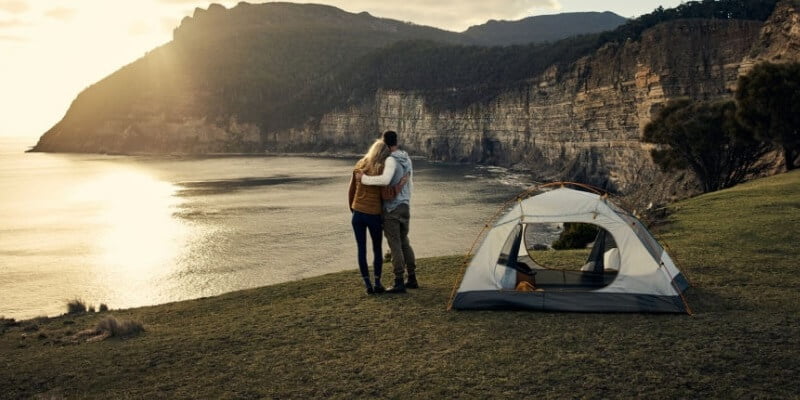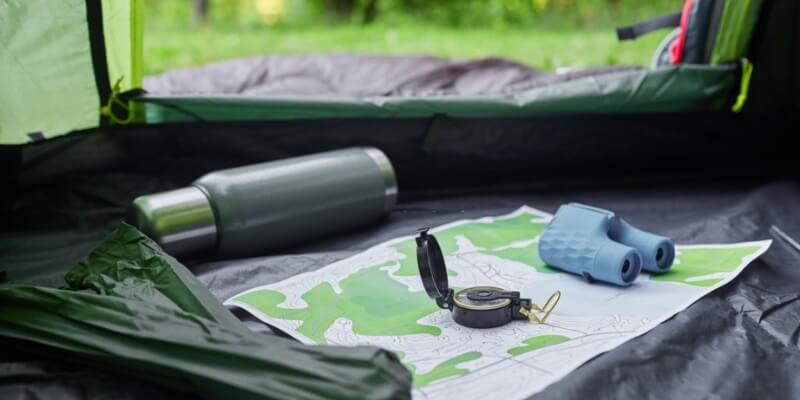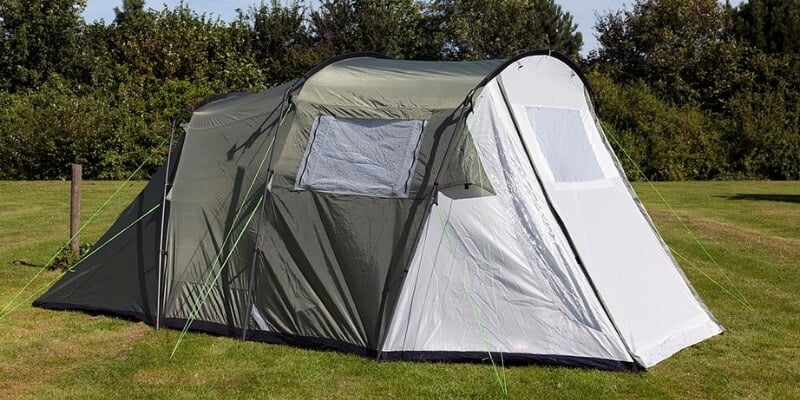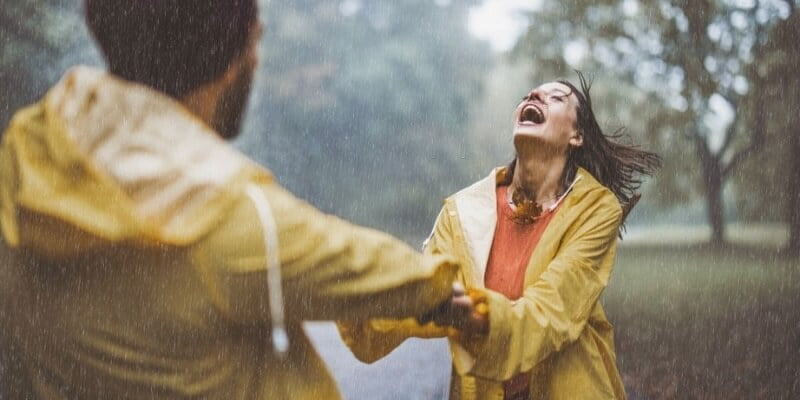20 Useful Tips for Tent Camping in the Rain
Picture this: dark clouds fill the sky, and the rain just won’t stop. You’re soaked, freezing, and stuck in a cold, muddy tent with a wet sleeping bag. It’s going to be a long night…
Now, let’s change that. Imagine sitting in your cozy, dry tent instead. You’re wrapped in a warm wool sweater, sipping hot mulled wine under the soft glow of string lights, listening to the soothing rain. Sounds better, right?
Rainy camping doesn’t have to be miserable! With a few simple tricks, the right gear, and some smart planning, you can stay dry and cozy—even in the worst downpour. Let’s explore the 20 tips to keep your rainy camping trip fun and comfortable!
1. Find the right campsite

No matter how soft the moss or how lush the grass looks, never set up your tent in a low-lying area! Even a small dip in the ground can turn into a pond during heavy rain, and you don’t want your tent to be the basin. Also, avoid setting up under trees when it’s raining—they may seem like good cover, but after the rain stops, droplets will keep falling on your tent (and on you!).
Instead, pick a spot where the sun can dry things out quickly. And if you’re like me and hate walking long distances in bad weather, aim for a campsite near the toilets and washrooms—it’ll make those rainy-day trips a lot easier!
2. Test your tent at home with a garden hose
Not all tents are built to withstand rain. Some can get damaged by strong winds or stray sparks from a barbecue. Even brand-new tents can have small defects in the seams, allowing water to seep in. But don’t worry—you can easily check if your tent is waterproof before heading out on your trip.
Set up your tent in the garden, close all the doors and windows, and simulate a rainstorm using a garden hose, lawn sprinkler, or even a watering can. This “rain” will reveal any weak spots. If you see water droplets inside, it’s time for repairs. To solve even the smallest leaks, run a sheet of blotting paper along the inner walls to find tiny drops or holes in the fabric. This simple test can save you a lot of trouble on a rainy day!
3. Make your tent waterproof
Before your camping trip, it’s crucial to waterproof your tent to avoid waking up with cold water dripping on your face! For leaky seams, use a seam sealer. Make sure to choose a silicone-based sealer if your tent has a silicone coating. You can also use it to patch up small holes in the fabric. I always keep a tube of seam sealer in my gear, just in case of any quick fixes during the trip.
Older tent fabrics tend to soak up water more easily, so it’s good practice to inspect your tent regularly. A little care goes a long way in keeping your tent waterproof and in great condition for future adventures!
4. Bring the right tent
Camping in the rain is so much more comfortable when you have a solid crap-weather tent. Sealed seams and a water column of at least 2,000 mm reliably keep the rain out. Double-walled tents protect you from the nasty condensation that forms inside your tent tarpaulin in damp weather.
A fully sealed tent floor keeps water from sneaking in, so you stay dry all night. A roomy awning is perfect for stashing wet gear and keeping your sleeping area cozy. Look for tents with smart designs that set up quickly—the faster you pitch it, the less rain you’ll face. Some tents let you put up the rainfly first. Ceiling loops are also great for hanging wet clothes and socks.

waterproof: 4,500 mm water column & taped seams
5. Right tent fabrics: polyester yes, cotton no!
Tents made of cotton are not a good idea because cotton gets wet quickly and dries very slowly! It doesn’t even have to rain for that. A high level of humidity and sweat is sufficient. However, polyester or nylon is much better. The lightweight synthetic fibers absorb less moisture and dry much faster.
6. Treat your inner tent like a dry sanctuary

Your most important equipment should be stored in your inner tent. It’s also immensely important that you stay dry while you sleeping so that you don’t get chilled at night! So leave your wet shoes and rainwear in the outer tent. This will prevent your sleeping bag from getting wet. You can also reduce the build-up of condensation in the inner tent.
Has your backpack soaked you full of water? Hopefully, you’ve stowed its contents in dry plastic bags! Take the dry contents with you into your inner tent and hang the backpack overnight in the outer tent so that it can drain off.
7. Open the ventilation flaps
Even when it rains, open the ventilation flaps on your tent so that warm or moist air won’t flow outside properly. This is especially crucial after sunset time when it is colder and wild outside. This will also reduce condensation in the tent at night.
8. Wear the right rain jacket
The right camping rainwear will help you stay dry when you go out and keep your body warm when relaxing. For us, these rain jackets have proven to be ideal:
- Long raincoat: An extra-long raincoat is easy to throw on if you walk outside the door. The coat is also much longer than a rain jacket. That’s why your pants stay dry too. However, if you want to transport a backpack or large dry items, use a wide rain poncho instead.
- Breathable all-weather jacket. On longer tours in the rain, we prefer to wear breathable, waterproof, and weatherproof jackets. These jackets are comfortable because they have a breathable membrane and transport sweat outside the tent during physical exertion. If possible, choose a model with ventilation openings under the arms so that you can regulate the temperature. It is also important that the zippers are waterproof.
In heavy rain, water-repellent fabrics won’t keep you dry. You need a jacket with a waterproof coating! To identify truly waterproof clothing, check the water column rating—this measures how much water pressure the fabric can withstand before it starts to leak.
9. Wet clothes should hang up & hang out
When you get wet, it might be tempting to toss your damp clothes in a bag and change into dry ones, but don’t! This can lead to mold and mildew. Instead, hang your clothes up to dry using a clothesline in your awning or under a pavilion. Many campsites even have drying rooms or clothes dryers. It takes a little time, but having dry, fresh-smelling clothes makes your camping trip much more enjoyable!
10. Choose the right sleeping bag that dries quickly
A down sleeping bag is light and wonderfully warm – until it gets damp. Then the down clumps and loses its insulating effect. You can buy a good quality sleeping bag for less than $100, but make sure it is efficient enough in uncertain weather. Synthetic sleeping bags are ideal when the humidity is high. They won’t clump and keep their insulating effect when get wet. Another advantage is they dry quickly.
Would you like even more protection against moisture and cold?
Then a packsack is right for you. This additional layer of insulation protects your sleeping bag from moisture and helps to keep the heat at night. However, the packsack should be breathable so that no condensation forms in the sack.
11. Choose water-repellent and waterproof pants
Leave your favorite cotton jeans at the campsite today. Cotton soaks up water and dries slowly. Water-repellent, quick-drying, functional pants made of synthetic fiber that protect you from getting soaked. In heavy rain, you need waterproof pants that you can pull over your functional pants. Just like your jacket, the pants should have a water protection coating and ideally a breathable membrane made of Gore-Tex or comparable material.
12. Dry feet are happy feet!
After a downpour, the air is clean, pure and fresh. A hike is now a special experience! However, damp grass and wet leaves can get you wet in no time. Dripping shoes is no fun. Waterproof hiking boots give you a good grip and stay dry in the mud. You can give your boots additional protection from water and dirt by freshly waterproofing them before camping in the rain.
For short distances on the campsite, we also take a pair of slippers or waterproof sandals with us. They’re quick to put on and take off; you can wear them in the shower too. Another important piece of advice to keep your feet happy: Take spare socks with you. I mean lots of spare socks. And keep a dry pair that you only wear in the tent.
13. Use old newspaper to save your shoes
Put dry newspaper in your wet shoes to help them dry faster. The paper absorbs moisture very well. You can also light a cozy campfire with the newspaper! Of course, kitchen paper is suitable for this purpose. However, old newspapers have the advantage that they are unrivaled in terms of price – they cost nothing.
14. Take plastic bags with you
When it’s pouring rain and the wind is shaking your tent, large waterproof garbage bags and small zippered bags become invaluable. Use large garbage bags to keep your backpack and gear dry while walking through the rain, and stash muddy shoes or wet pants inside to protect everything else. Before the storm hits, gather dry firewood in a plastic bag so you can easily start a crackling campfire afterward. It’s also smart to pack an “emergency bag” with spare clothes (don’t forget extra socks!), food, medication, sensitive electronics, and any gear that absolutely must stay dry.
15. Position the tent entrance on the leeward side
Position your tent so that the entrance faces away from the wind. This simple trick will help keep rain from pouring into your tent when you open the door. This setup has another advantage: the morning sun won’t shine directly into your sleeping area at sunrise, allowing you to enjoy a more restful sleep.
16. Brace your tent really well

To prevent water from pooling on your tent, a small puddle on the roof isn’t usually a big deal, but remember that water is heavy! A large pool can damage the tent and seep in surprisingly quickly. I learned this the hard way on Texel one morning when I woke up to a leak right over my face. Good morning, nature!
You can avoid such surprises by tensioning your tent properly. Make sure there are no sagging areas and create tension in the flysheet. A great technique is to stretch the guy ropes out from the center of the tent.
17. Use a tent pad under the tent
Tents often get flooded from below rather than above. This can happen when sharp objects puncture tiny holes in the tent floor. To avoid this soggy fate, place a tarp under your tent. A sturdy, lightweight tarp will protect your tent floor from sharp stones, water, and mud, making it easier to clean up after your trip.
Just be sure that the tarp doesn’t stick out from under the tent! If it does, rainwater can collect underneath. Tuck any protruding corners under the tent floor until the tarp is completely hidden. That way, you’ll stay dry and comfortable throughout your camping adventure!
18. Dry your equipment and your tent
Damp objects tend to mold. So don’t forget to dry your other gear and tent after your outing in the rain before packing them away at home. The easiest way is to spread the tent out on the ground in the sun. Make sure to open the doors beforehand. The clothesline in the basement is also good, the tumble dryer is taboo.
19. Pass on your wisdom
Camping in the rain is a skill that sets experienced campers apart from the rest. Knowing how to stay dry and have fun despite bad weather can make those who are less prepared a little envious! Remember those chilly days spent in a damp tent, and use that experience to share your wisdom with fellow campers. They’ll appreciate your tips and tricks for enjoying the outdoors, even on rainy days!
20. Enjoy the rain

The relaxing, rhythmic drumming of the raindrops on your tent roof. The wind rustles in the treetops. The clear and fresh air after the rain shower. Rain has a beautiful side. Read a good book and play exciting board games with your family and friends.
- You can also read: 15 tips: camping in the rain is still fun
Conclusion
Camping in the rain doesn’t have to be a miserable experience. If you follow these tips, you can enjoy the rain comfortably and dry your tent with ease, allowing you to relax and unwind. How do you stay dry while camping in the rain? I’d love to hear your tips and tricks! Share your thoughts in the comments section below.





